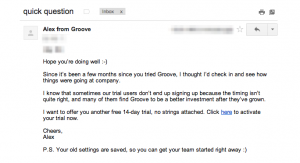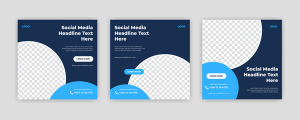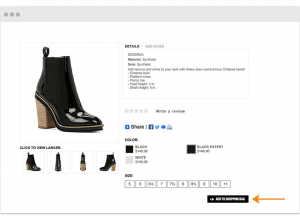
Recently, free dating app giant Tinder has been undergoing a courtship of their own: with marketers and advertisers, that is.
The app is joining the trend of introducing purchasable ad space in the world of online dating. The realms of online dating and marketing provide each other with natural collaborators, as they both involve presenting a particular image or message to the audience that is most desirable to you – whether for your heart or your bottom line. In fact, we even built an April Fool’s joke around the idea of a dating site specifically designed for the audience of marketing professionals. We did it for laughs (mostly), but the parallels were immediately apparent.
It’s an expected move, but a big one, as the user experience has largely been ad-free since Tinder’s rollout in 2012. It’s always difficult to gauge how users will respond to the introduction of ads. Pinterest, for example, suffered some significant user backlash once it started rolling out its ‘Promoted Pins’ offerings.
On the one hand, an ad-free user experience is always preferable because it is free of annoyance and far more seamless. On the other, app users aren’t ignorant to the business side of advertising in 2015. They understand, for the most part, that if a company like Tinder needs to sell ad space as a way to keep the app free to download, it’s a reasonable concession to make as a customer.
Tinder is not the first online dating company to use ad space as an added source of revenue. Companies such as Match and Meet Me have had ads included in their applications for years. Tinder, though, enjoys a particularly strong brand engagement amongst millennials: often being cited as the first company of its kind to overcome the social stigma that other online dating companies have suffered in the past. So, the key for Tinder will be to introduce the advertisements in a way that still avoids those stigmas. Creativity will be king.
What has worked for other online dating companies?
Dating apps are all different and therefore have different ways of getting their ads into the picture. Meet Me, for example, has a newsfeed element similar to something you would see on Facebook. This is advantageous because including an ad in the newsfeed doesn’t feel so interruptive, since it can be immediately cascaded past. Facebook (and its users) have found this to be the case and exploited it successfully as well.

Tinder won’t have that option. With tinder, profiles of potential matches will, for the most part, be presented as large cards that take up the entire screen. There is a scrolling element to perusing individual pictures within a profile, but you wouldn’t want to inject advertisement content directly into someone’s personal profile, as it would compromise their ability to properly present themselves to the dating world.
So, then, Tinder will have to include its ads as entire profiles – that one might swipe into after swiping past a previous (real) profile. This presents an interesting framework of challenges for advertisers. Because the ads will look and feel almost identical to the actual profiles (once again – for the most part, we’ll discuss an early counterexample below), the onus is on those companies to take advantage of this. They can do this by putting a premium on content that is specific to the arena in which it is being displayed.
Be thematically relevant.
Aside from positioning ads as actual profiles, brands will be best-suited to introduce the themes of dating and love into their actual ad content.
Another online dating giant – OkCupid – has seen advertisers implement successfully create thematically relevant content. Pizza Hut, for example, included a dating profile (similar to how brands will have to build seemingly real profiles) wherein users will compete to see who can dish out the best marriage proposal to their pizza. The profile includes funny tidbits like: “Education: PhD in Delicious” and “Body Type: Light & Airy.” Whomever is deemed by Pizza Hut to have offered the best (or more realistically, the funniest) marriage proposal stands to win a lifetime of free pizza. The humor is genuinely funny, the potential reward is extremely valuable, and most importantly, the content is thematically relevant.
One early Tinder ad from Fox – specifically for the upcoming film, Spy – does a great job of executing this type of strategy as well, indicating that Tinder is very securely on the right track. Via the ad, users can ‘swipe right’ on the film’s profile to enter for a chance to win tickets to a special advanced screening of the film. Not only is it a great idea to introduce a promotional contest into the equation, but the studio has positioned its ad as directly relatable to the arena in which it is presented. Two ‘matches’ have the opportunity to use the ad as an ice-breaker for conversation, and then eventually also use it to get a discount on their actual first date. This is very smart advertising and should mean success for Tinder, Fox Studios, and hopefully those two fateful lovebirds.
Use video so they know it’s real.
Another early Tinder advertising foray, from Bud Light, makes use of the thematic strategies discussed above, but with even more vibrancy and excitement brought about by the flashy video. The video harkens back to last year’s campaign from Bud Light, in which it staged a surprise takeover of a town and temporarily renamed it ‘Whatever, USA.’ With this campaign, 21+ Tinder users who swipe right for the ad will be transported to a landing page where they can enter to win a chance to visit this year’s version of ‘Whatever, USA.’
As Adweek states, “Bud Light will soon be bragging about how many Tinder couples met (or had a rendezvous in Whatever, USA).”
This ad is another good example of using thematic relevancy to make the ad seem less interruptive and more like it’s all part of the Tinder experience. It does more than that though, as well. It introduces a vibrant and live video into the equation. With a lot of promotions, a video of this type might elicit an unsavory reaction from users. We don’t anticipate that to be the case with this ad, though. Bud Light knows both their demographic and Tinder’s demographic have a lot of overlap: employed, single, millennials. These are precisely the type of customers that would love nothing more than a free trip to Whatever, USA for three days of partying with other – you guessed it – a whole bunch of other employed, single, millennials.
On the other hand, the ad is a little bit of a risk. On Bud Light’s side of things, they’re promoting a reward that offers big gains but also big commitment. Unlike with Spy, which only requires the commitment of a few hours, they could potentially run into users who simply cannot or aren’t willing to take a three day trip during the middle of the year, regardless of the fact that the ad was presented as relevant to the app they happened to be using when they saw it. For Tinder as well, introducing video carries with it a heavier effect on user experience.
How those users respond to these kinds of ads remains to be seen, but it’s clear that both Tinder and the brands making use of its new ad space are treading some relatively new ground, especially considering the audience involved. It will be interesting to see which strategies prove most effective and how that will affect the UX for millennials looking for love.
(283)









